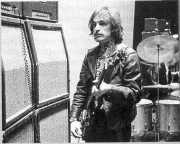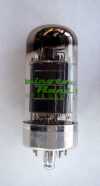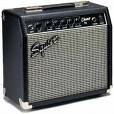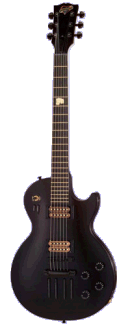Electric Guitar Amps
 Electric guitars do not produce any audible sounds, they have electro-magnetic "Pickups" that convert the vibration of the strings into an electrical signal. The electric guitar is plugged into an Amplifier (Amp), which produces sounds from the vibration signal it receives. All electric guitars require an amp or other electric amplification device. Acoustic-electric guitars, however, do make audible sounds - as they are essentially acoustic guitars with a built in pickup microphone. You can plug an acoustic-electric guitar to an amp to increase the volume, or to use guitar effects with it. Guitar amps are rated in Watts, which is the amount of power they draw. The amount of power is directly proportional to the volume level a guitar amp is capable of; the higher the wattage, the louder the amp. For home use a 10 or 20 Watt amp should be sufficient. Concert halls use multiple 1000+ Watt amps, but they are huge spaces. Guitar amps have a speaker in the casing; and amps with higher power ratings have larger speakers, which increases the overall size of the amp case. You may have noticed huge stacks of speakers behind your favorite rock guitarist (see picture above).
Electric guitars do not produce any audible sounds, they have electro-magnetic "Pickups" that convert the vibration of the strings into an electrical signal. The electric guitar is plugged into an Amplifier (Amp), which produces sounds from the vibration signal it receives. All electric guitars require an amp or other electric amplification device. Acoustic-electric guitars, however, do make audible sounds - as they are essentially acoustic guitars with a built in pickup microphone. You can plug an acoustic-electric guitar to an amp to increase the volume, or to use guitar effects with it. Guitar amps are rated in Watts, which is the amount of power they draw. The amount of power is directly proportional to the volume level a guitar amp is capable of; the higher the wattage, the louder the amp. For home use a 10 or 20 Watt amp should be sufficient. Concert halls use multiple 1000+ Watt amps, but they are huge spaces. Guitar amps have a speaker in the casing; and amps with higher power ratings have larger speakers, which increases the overall size of the amp case. You may have noticed huge stacks of speakers behind your favorite rock guitarist (see picture above).
 The original guitar amps (and all electronic devices of that day) used Vacuum Tubes, which were the precursors to our modern day miniature transistor. Vacuum tubes were delicate (they were made of glass) and prone to overheating. Today, most guitar amps are "solid state" - using transistors and other silicon chip technology that is sturdy and uses less power. However, the sound quality from a tube amp is far superior to modern solid state amps - so tube amps are still available. Today's tube amps tend to be more expensive, and cost more to maintain (in replacing burnt out vacuum tubes) - they are usually the choice of professional musicians. For home and hobby use, cheaper solid state guitar amps are just fine.
The original guitar amps (and all electronic devices of that day) used Vacuum Tubes, which were the precursors to our modern day miniature transistor. Vacuum tubes were delicate (they were made of glass) and prone to overheating. Today, most guitar amps are "solid state" - using transistors and other silicon chip technology that is sturdy and uses less power. However, the sound quality from a tube amp is far superior to modern solid state amps - so tube amps are still available. Today's tube amps tend to be more expensive, and cost more to maintain (in replacing burnt out vacuum tubes) - they are usually the choice of professional musicians. For home and hobby use, cheaper solid state guitar amps are just fine.
 Several types of guitar amps are available today, and come with many features and effects built-in. Volume and tone controls, of course, are standard - that is how you control the amount and tone of sound. The Reverb effect is available in many guitar amps, this simple and elegant effect provides a warmth to guitar music. Another effect that is commonly available in guitar amps is the Distortion effect. Using Pre and Post Gain controls, guitarists can alter the sound of their guitar - from a flat "thunk" to a screeching "wail". If you are lucky enough to have a spouse that also plays guitar, some amps have Dual input jacks - so both of you can play together. For the opposite case, where the spouse keeps yelling at you to TURN THAT DARN THING DOWN, some amps have a Headphone jack - so you can plug in and tune out. Can you dig it? I knew that you could. And for those play-along guitarists, some amps have a CD Input jack - so you can plug your CD player in and play along with your favorite music.
Several types of guitar amps are available today, and come with many features and effects built-in. Volume and tone controls, of course, are standard - that is how you control the amount and tone of sound. The Reverb effect is available in many guitar amps, this simple and elegant effect provides a warmth to guitar music. Another effect that is commonly available in guitar amps is the Distortion effect. Using Pre and Post Gain controls, guitarists can alter the sound of their guitar - from a flat "thunk" to a screeching "wail". If you are lucky enough to have a spouse that also plays guitar, some amps have Dual input jacks - so both of you can play together. For the opposite case, where the spouse keeps yelling at you to TURN THAT DARN THING DOWN, some amps have a Headphone jack - so you can plug in and tune out. Can you dig it? I knew that you could. And for those play-along guitarists, some amps have a CD Input jack - so you can plug your CD player in and play along with your favorite music.
To read the next page, click the link marked Next>>> below.

 Electric guitars do not produce any audible sounds, they have electro-magnetic "Pickups" that convert the vibration of the strings into an electrical signal. The electric guitar is plugged into an Amplifier (Amp), which produces sounds from the vibration signal it receives. All electric guitars require an amp or other electric amplification device. Acoustic-electric guitars, however, do make audible sounds - as they are essentially acoustic guitars with a built in pickup microphone. You can plug an acoustic-electric guitar to an amp to increase the volume, or to use guitar effects with it. Guitar amps are rated in Watts, which is the amount of power they draw. The amount of power is directly proportional to the volume level a guitar amp is capable of; the higher the wattage, the louder the amp. For home use a 10 or 20 Watt amp should be sufficient. Concert halls use multiple 1000+ Watt amps, but they are huge spaces. Guitar amps have a speaker in the casing; and amps with higher power ratings have larger speakers, which increases the overall size of the amp case. You may have noticed huge stacks of speakers behind your favorite rock guitarist (see picture above).
Electric guitars do not produce any audible sounds, they have electro-magnetic "Pickups" that convert the vibration of the strings into an electrical signal. The electric guitar is plugged into an Amplifier (Amp), which produces sounds from the vibration signal it receives. All electric guitars require an amp or other electric amplification device. Acoustic-electric guitars, however, do make audible sounds - as they are essentially acoustic guitars with a built in pickup microphone. You can plug an acoustic-electric guitar to an amp to increase the volume, or to use guitar effects with it. Guitar amps are rated in Watts, which is the amount of power they draw. The amount of power is directly proportional to the volume level a guitar amp is capable of; the higher the wattage, the louder the amp. For home use a 10 or 20 Watt amp should be sufficient. Concert halls use multiple 1000+ Watt amps, but they are huge spaces. Guitar amps have a speaker in the casing; and amps with higher power ratings have larger speakers, which increases the overall size of the amp case. You may have noticed huge stacks of speakers behind your favorite rock guitarist (see picture above).
 The original guitar amps (and all electronic devices of that day) used Vacuum Tubes, which were the precursors to our modern day miniature transistor. Vacuum tubes were delicate (they were made of glass) and prone to overheating. Today, most guitar amps are "solid state" - using transistors and other silicon chip technology that is sturdy and uses less power. However, the sound quality from a tube amp is far superior to modern solid state amps - so tube amps are still available. Today's tube amps tend to be more expensive, and cost more to maintain (in replacing burnt out vacuum tubes) - they are usually the choice of professional musicians. For home and hobby use, cheaper solid state guitar amps are just fine.
The original guitar amps (and all electronic devices of that day) used Vacuum Tubes, which were the precursors to our modern day miniature transistor. Vacuum tubes were delicate (they were made of glass) and prone to overheating. Today, most guitar amps are "solid state" - using transistors and other silicon chip technology that is sturdy and uses less power. However, the sound quality from a tube amp is far superior to modern solid state amps - so tube amps are still available. Today's tube amps tend to be more expensive, and cost more to maintain (in replacing burnt out vacuum tubes) - they are usually the choice of professional musicians. For home and hobby use, cheaper solid state guitar amps are just fine.
 Several types of guitar amps are available today, and come with many features and effects built-in. Volume and tone controls, of course, are standard - that is how you control the amount and tone of sound. The Reverb effect is available in many guitar amps, this simple and elegant effect provides a warmth to guitar music. Another effect that is commonly available in guitar amps is the Distortion effect. Using Pre and Post Gain controls, guitarists can alter the sound of their guitar - from a flat "thunk" to a screeching "wail". If you are lucky enough to have a spouse that also plays guitar, some amps have Dual input jacks - so both of you can play together. For the opposite case, where the spouse keeps yelling at you to TURN THAT DARN THING DOWN, some amps have a Headphone jack - so you can plug in and tune out. Can you dig it? I knew that you could. And for those play-along guitarists, some amps have a CD Input jack - so you can plug your CD player in and play along with your favorite music.
Several types of guitar amps are available today, and come with many features and effects built-in. Volume and tone controls, of course, are standard - that is how you control the amount and tone of sound. The Reverb effect is available in many guitar amps, this simple and elegant effect provides a warmth to guitar music. Another effect that is commonly available in guitar amps is the Distortion effect. Using Pre and Post Gain controls, guitarists can alter the sound of their guitar - from a flat "thunk" to a screeching "wail". If you are lucky enough to have a spouse that also plays guitar, some amps have Dual input jacks - so both of you can play together. For the opposite case, where the spouse keeps yelling at you to TURN THAT DARN THING DOWN, some amps have a Headphone jack - so you can plug in and tune out. Can you dig it? I knew that you could. And for those play-along guitarists, some amps have a CD Input jack - so you can plug your CD player in and play along with your favorite music.